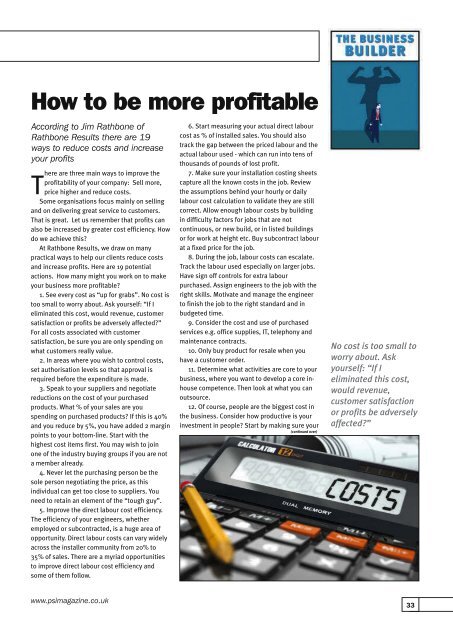PSISeptember2017a
You also want an ePaper? Increase the reach of your titles
YUMPU automatically turns print PDFs into web optimized ePapers that Google loves.
How to be more profitable<br />
According to Jim Rathbone of<br />
Rathbone Results there are 19<br />
ways to reduce costs and increase<br />
your profits<br />
here are three main ways to improve the<br />
Tprofitability of your company: Sell more,<br />
price higher and reduce costs.<br />
Some organisations focus mainly on selling<br />
and on delivering great service to customers.<br />
That is great. Let us remember that profits can<br />
also be increased by greater cost efficiency. How<br />
do we achieve this?<br />
At Rathbone Results, we draw on many<br />
practical ways to help our clients reduce costs<br />
and increase profits. Here are 19 potential<br />
actions. How many might you work on to make<br />
your business more profitable?<br />
1. See every cost as “up for grabs”. No cost is<br />
too small to worry about. Ask yourself: “If I<br />
eliminated this cost, would revenue, customer<br />
satisfaction or profits be adversely affected?”<br />
For all costs associated with customer<br />
satisfaction, be sure you are only spending on<br />
what customers really value.<br />
2. In areas where you wish to control costs,<br />
set authorisation levels so that approval is<br />
required before the expenditure is made.<br />
3. Speak to your suppliers and negotiate<br />
reductions on the cost of your purchased<br />
products. What % of your sales are you<br />
spending on purchased products? If this is 40%<br />
and you reduce by 5%, you have added 2 margin<br />
points to your bottom-line. Start with the<br />
highest cost items first. You may wish to join<br />
one of the industry buying groups if you are not<br />
a member already.<br />
4. Never let the purchasing person be the<br />
sole person negotiating the price, as this<br />
individual can get too close to suppliers. You<br />
need to retain an element of the “tough guy”.<br />
5. Improve the direct labour cost efficiency.<br />
The efficiency of your engineers, whether<br />
employed or subcontracted, is a huge area of<br />
opportunity. Direct labour costs can vary widely<br />
across the installer community from 20% to<br />
35% of sales. There are a myriad opportunities<br />
to improve direct labour cost efficiency and<br />
some of them follow.<br />
6. Start measuring your actual direct labour<br />
cost as % of installed sales. You should also<br />
track the gap between the priced labour and the<br />
actual labour used - which can run into tens of<br />
thousands of pounds of lost profit.<br />
7. Make sure your installation costing sheets<br />
capture all the known costs in the job. Review<br />
the assumptions behind your hourly or daily<br />
labour cost calculation to validate they are still<br />
correct. Allow enough labour costs by building<br />
in difficulty factors for jobs that are not<br />
continuous, or new build, or in listed buildings<br />
or for work at height etc. Buy subcontract labour<br />
at a fixed price for the job.<br />
8. During the job, labour costs can escalate.<br />
Track the labour used especially on larger jobs.<br />
Have sign off controls for extra labour<br />
purchased. Assign engineers to the job with the<br />
right skills. Motivate and manage the engineer<br />
to finish the job to the right standard and in<br />
budgeted time.<br />
9. Consider the cost and use of purchased<br />
services e.g. office supplies, IT, telephony and<br />
maintenance contracts.<br />
10. Only buy product for resale when you<br />
have a customer order.<br />
11. Determine what activities are core to your<br />
business, where you want to develop a core inhouse<br />
competence. Then look at what you can<br />
outsource.<br />
12. Of course, people are the biggest cost in<br />
the business. Consider how productive is your<br />
investment in people? Start by making sure your<br />
(continued over)<br />
No cost is too small to<br />
worry about. Ask<br />
yourself: “If I<br />
eliminated this cost,<br />
would revenue,<br />
customer satisfaction<br />
or profits be adversely<br />
affected?”<br />
www.psimagazine.co.uk<br />
33

















